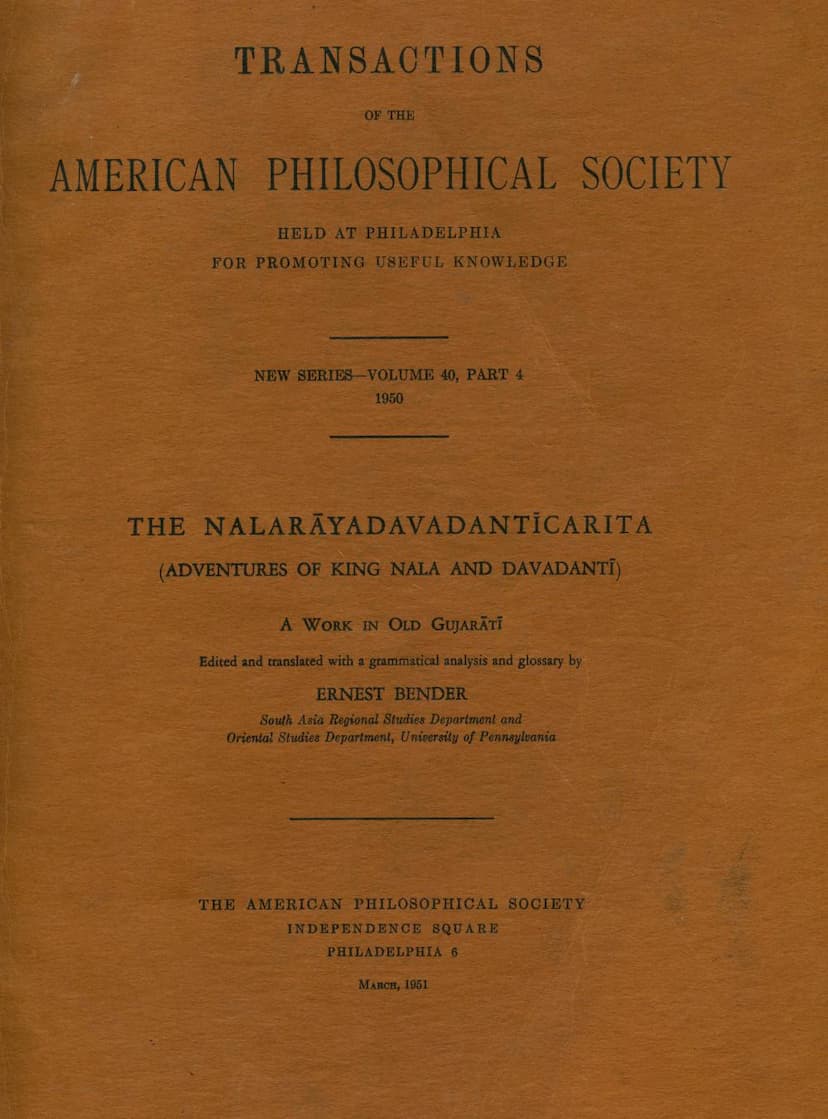Nalrayavadanti Charita
Added to library: September 2, 2025

Summary
Here is a comprehensive summary of the Jain text "The Nalarāyadavadanticarita" by Ernest Bender, based on the provided text:
Book Title: The Nalarāyadavadanticarita (Adventures of King Nala and Davadanti) Author: Ernest Bender Publisher: American Philosophical Society Publication Date: March, 1951 Series: Transactions of the American Philosophical Society, New Series, Volume 40, Part 4
Overview: "The Nalarāyadavadanticarita" is an Old Gujarati rendition of the famous Nala-Damayanti story, adapted for didactic purposes within the Jain tradition. Ernest Bender's work provides a critical edition, translation, grammatical analysis, and glossary of this Old Gujarati text, making it accessible to Western scholars.
Source Material: The edition is based on four paper manuscripts, designated B, H, P, and S. Manuscript P is noted as being in the best state of preservation, while the others, or their remaining portions, are also in good condition and clearly written in the Devanagari script. Bender details variations in the manuscripts concerning vowel representation, corrections, omissions, and stanza numbering.
The Story and its Significance: The Nalarāyadavadanticarita presents a Jain perspective on the Nala-Damayanti narrative, which is also found in the Brahmanical tradition, most notably in the Mahabharata. The Jain version, like other Jain adaptations of familiar stories, incorporates unique features to edify the audience with Jain religious teachings.
Key differences and characteristics highlighted by Bender include:
- Rebirth: Unlike the Mahabharata version, the Jain text emphasizes the concept of rebirth, tracing the protagonists' adventures through multiple previous existences. These past lives influence their present circumstances and subsequent rebirths, serving as a core didactic element.
- Didactic Interventions: The narrative is interspersed with discourses by the narrator or characters that expound upon the virtues of attachment to Jain precepts. The entire story functions as a sermon on worthy conduct and its rewards.
- Separation Period: The Jain version states a separation period of twelve years for Nala and Davadanti, contrasting with the Mahabharata's four years.
- Davadanti's Power: While the Mahabharata is explicit about Damayanti performing miracles through her chastity (a "Truth-Act"), the Old Gujarati text is generally vague about Davadanti's power in this regard, though it consistently emphasizes the potency of female chastity.
- Nala's Skills: The Jain tales do not explicitly explain how Nala acquired his skills in cooking and charioteering, unlike the Mahabharata.
- Kali's Influence: The Jain version does not attribute Nala's misfortunes to possession by an evil spirit like Kali, but rather to his previous karma.
- Additional Rebirths: The Old Gujarati text includes an extra rebirth not found in other versions, where Nala becomes Dhanada (Kuvera) and Davadanti becomes his consort, Kanakavati.
Grammatical Analysis: Bender provides a detailed grammatical analysis covering:
- Phonology: He outlines the phonemic distinctions of Old Gujarati as evident in the manuscripts, including vowels, diphthongs, and consonants. He discusses variations in spelling, vowel length, the use of the anusvāra, and the representation of certain sounds, noting differences from Modern Gujarati.
- Morphology: This section is extensive, detailing the declension of nouns, adjectives, and pronouns, with their genders, numbers, and seven cases. It systematically analyzes nominal bases, nominalizing suffixes, and the formation of verb bases, participles, and infinitives. Bender provides numerous examples from the text to illustrate these points.
- Syntax: Bender discusses sentence structures, including equational and narrative sentences, and how basic elements (subject, predicate, object) are expanded by attributes, postpositional phrases, and subordinate clauses. He also examines the normal word order and variations for emphasis, noting how metrical and rhyme requirements in poetry necessitate deviations from prose order.
Text and Translation: The book includes the Old Gujarati text of the Nalarāyadavadanticarita, with extensive critical notes and apparatus, followed by an English translation.
Glossary and References: A comprehensive glossary is provided, listing Old Gujarati words with their English equivalents, grammatical information, and etymological connections. An extensive list of references is also included, pointing to various linguistic and literary studies relevant to the text.
Overall Contribution: Ernest Bender's "The Nalarāyadavadanticarita" is a significant scholarly contribution, offering a critical edition and translation of an important Old Gujarati Jain text. It provides invaluable insights into the Jain adaptation of a classical Indian story, the linguistic features of Old Gujarati, and the didactic methods employed in medieval Jain literature.